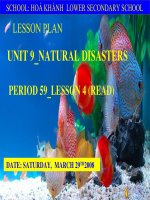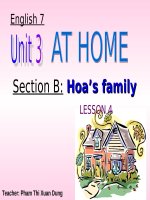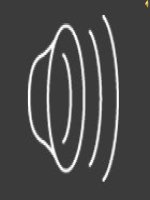Unit 3 lesson 4 read period 15 week 5
Bạn đang xem bản rút gọn của tài liệu. Xem và tải ngay bản đầy đủ của tài liệu tại đây (71.5 KB, 3 trang )
Gi¸o ¸n TiÕng anh 8
Phßng gi¸o dôc MÜ hµo
Trêng thcs d¬ng quang
TuÇn: 5
Ngµy so¹n:
d¹y:
TiÕt: 15
Ngµy
Unit 3 at home
Lesson 4 Read
A. The objectives
- By the end of the lesson, Ss will be able to read a text about Safety
precautions in the home for main ideas and details. They’ll complete the
reading tasks and use the language to talk about safety precautions using
Must/ mustn’t / Have to
b. content: Present simple tense to talk about factual actions; Must/ Have to
to talk about obligations.
Vocabulary: words to talk about safety precautions in the home.
C. Materials: Posters, OHP, transparent papers,
Work arrangements: Individuals, pairs, groups, T-WC
Anticipated problems: difficult text and vocabulary; Why-questions
D. Procedure
I. Warmer
Dictation list
Teacher dictates, students take
dictation and write the words into
two columns.
Share and compare
Teacher gets feedback
Why do you think these things are
dangerous to young children?
What else do you think can be
dangerous to our children?
II. Checking the old lesson
III. New lesson
Pre-reading
Pre-teach
Eliciting
Modeling, choral & individual
repetition
Written record, pronunciation, VN
meaning
Checking vocabulary: R. O. R
Not
dangerous at
all
A cushion
An armchair
Dangerous to
young
children
A knife
A stove
A rice cooker
drug
I. Vocabulary
- safety (n):
- precaution (n):
- injure (v):
- destroy (v):
- cause a fire:
- out of children’s reach:
- include (v):
- match (n):
- cover (v):
Vò M¹nh Hµ / / 0982928076
1
Open prediction: Set the scene:
We’re going to talk about Safety
precautions in the home.
- What do you think can be
dangerous to children in the
home?
- Where shouldn’t play in the
house? Why?
Ask students to work on their own
first then they pair and compare
While-reading
Ask students to read the poster
and check their predictions.
True/ False statements
Ask students to read the text again
and do the True/ False exercise.
Students work individually, pair
and compare
Teacher gets feedback: Correct the
false sentences/ Which sentences
in the text tell you it’s true?
Comprehension questions
Ask students to read the text again
and answer the questions
Students work in pairs
Teacher gets some pairs to ask and
answer the questions aloud.
Do the correction
Post-reading
Make a class poster
Safety precautions in the home
Organize group work, each group
makes a poster and exhibit it.
II. Read
Things can be dangerous to
children:
- matches, drugs, chemicals,
electricity, hot water in the jar, gas
stove, knives, scissors, …
- Children shouldn’t play in the
kitchen, bathroom,
1. Answer
b. True
c. False. A kitchen is a dangerous
place to play.
d. False. … can cause a fire.
e. True
f. True
2. Ask and answer
b. Because the kitchen is a
dangerous place
c. Because playing with matches
can cause a fire. (It only takes one
match to cause a fire)
d. Because children mustn’t try to
put …
e. Because these dangerous
objects can injure or kill children.
Safety precautions in the home
Children mustn’t play in the
bathroom because they may
slip and fall down.
Make sure children mustn’t
play with jars with hot water
inside.
Make sure children mustn’t
play near the doors and
windows
etc
Vò M¹nh Hµ / / 0982928076
2
IV. Consolidation
V. Homework
Talk about safety precautions in
the home
Must/ have to
Study vocabulary by heart
Dictation and translation. Do the
exercises again.
Practice talking about safety
precautions
Prepare new lesson: Write
..........................................................................................................
..........................................................................................................
Vò M¹nh Hµ / / 0982928076
3









